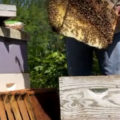By Bruce Bordelon, Ph.D.
Viticulture Specialist
Purdue University
- Production 60% of normal due to Easter freeze
- Early harvest prevented lady beetle damage
The 2007 growing season was unusually warm and dry across much of the Midwest. The year’s most significant event was the “Easter Freeze” that hit much of the region. After record warm temperatures in March, early April brought several days of below freezing temperatures. Many fruit crops across the region were severely damaged. Most of Indiana’s vineyards had shoot growth of 1 to 6 inches at the time of the freeze, and were damaged severely. Fortunately, secondary buds on most varieties were highly fruitful and a reasonably good crop was produced. Overall production was about 60% of normal.
The summer months were hot and dry. Growing degree-day accumulation was about 25% above average. Rainfall was about 75% of normal in most areas, but less than 50% of normal in southeast Indiana. Grape disease pressure was minimal, due to the dry conditions. Powdery mildew was the only disease of any concern.
Harvest dates were about normal for early grape varieties, but the season was compressed, with many of the mid- and late season varieties harvested one to two weeks earlier than normal. The multi-colored Asian lady beetle was not a problem this season, because the early harvest occurred before beetles began to move into grapes.
Fruit quality was excellent overall. The 2006-07 winter was slightly warmer than normal, and winter injury was minor. Coldest temperatures occurred in early to mid-February, and ranged from 0[degrees]F in the southern half to -12[degrees]F in northern Indiana.
Demand for Indiana-grown grapes continues to outpace supply, which has led to a modest increase in acreage. Most of the new plantings have been in the premium hybrids, but some vinifera varieties are being produced on the best sites. Indiana currently has 36 wineries, with several expected to open in the near future.
Indiana wine sales exceeded 700,000 gallons in 2006. Welcoming more than 1 million visitors each year, the Indiana wine industry contributes more than $34 million to the state’s economy, and is the state’s No. 1 agri-tourism destination. For additional information about the Indiana wine industry, please visit indianawines.org.





Leave a Reply